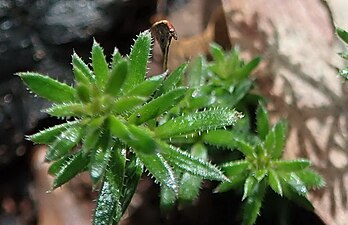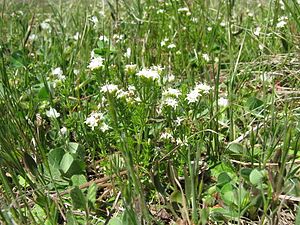Banksia densa is a species of column-like shrub that is endemic to Western Australia. It has deeply serrated to pinnatifid leaves, creamy yellow flowers in heads of up to seventy-five, and hairy follicles.

Acaena novae-zelandiae, commonly known as red bidibid, bidgee widgee, buzzy and piri-piri bur, is a small herbaceous, prostrate perennial, native to New Zealand, Australia and New Guinea, of the family Rosaceae.

Lophostemon confertus, is an evergreen tree native to Australia, though it is cultivated in the United States and elsewhere. Common names include brush box, Queensland box, Brisbane box, pink box, box scrub, and vinegartree. Its natural range in Australia is north-east New South Wales and coastal Queensland but it is commonly used as a street tree in Sydney, Melbourne, Perth and other cities in eastern Australia.

Chrysocephalum semipapposum, commonly known as clustered everlasting is a perennial shrub native to Australia. Clustered everlasting belongs to the family Asteraceae. C. semipapposum produces terminal flowers heads in clusters, mainly between spring and early summer with silver-grey appearing stems and branches. It grows up to 40cm high and 60 cm high, although there have been some varieties which can grow up to 1 m. C. semipapposum is often confused with Chrysocephalum apiculatum or 'yellow buttons', due to their similar appearances. C. semipapposum has 4 different subspecies, however they lack distinctive qualities and are often hard to identify. C. semipapposum is endemic to Australia and can be found in multiple states, most notably within Victoria. The plant is found in a variety of habitats including dry rocky regions. Clustered everlasting often grows sparsely and is rarely found in abundance and can be mistaken for a weed. Clustered everlasting has many uses, including as a source of nectar for butterflies, cut flowers or as an addition to a garden.

Geranium potentilloides, belongs to the family Geraniaceae, and is a small prostrate perennial herb that can grow up to 60cm high. The species is commonly referred to as Soft Cranesbill or Cinquefoil geranium.

Ampera xiphloclada, commonly known as ‘broom spurge’,) is a grass-like erect shrub in the Euphorbiaceae family.
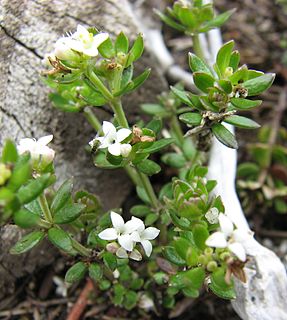
Asperula gunnii, the mountain woodruff, is a species of flowering plant in the family Rubiaceae. It is a perennial herb that is endemic to Australia.

Gahnia grandis is a tussock-forming perennial plant found in southeastern mainland Australia and Tasmania.

Monotoca scoparia, commonly known as prickly broom heath, is a widespread native species across south-eastern Australia. Monotoca scoparia was formerly in the family Epacridaceae but now belongs to the family Ericaceae. Monotoca is an endemic Australian genus with 17 described species occurring in all states.
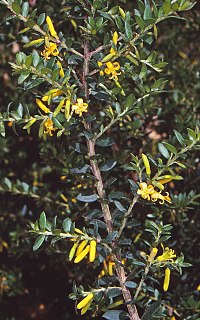
Persoonia asperula, commonly known as mountain geebung, is a plant in the family Proteaceae and is endemic to south-eastern Australia. It is an erect or prostrate shrub with smooth bark, mostly elliptic to oblong leaves and yellow flowers borne singly or in groups of up to nine. It mostly occurs in the Southern Highlands of New South Wales. A small population in Victoria may be a different species.

Dodonaea procumbens, commonly known as trailing hop bush or creeping hop-bush, is a species of shrub in the genus Dodonaea found in eastern Australia. It occurs in many places in Australia such as South Australia, New South Wales and Victoria. Although the information on the abundance of this species is limited, it is estimated that about 5,000 plants occur in about 55 wild populations. The species is currently facing many threats such as the expansion of road facilities, the development of residential and agricultural areas, increased grazing regimes, weed invasions, and regimes changing of fire. As a result, it is listed as vulnerable and threatened. Therefore, it is necessary to provide protective solutions for the long-term development and survival of this species.

Nymphoides crenata, commonly known as wavy marshwort, is an aquatic perennial herb of the family Menyanthaceae endemic to Australia, found in all mainland states and the Northern Territory

Lomandra effusa is a perennial, dioecious, rhizomatous herb native to Australia. It is a perennial tussock with bluish green, large, arching leaves which are distinctive by the two toothed leaf tip. It has white, cream or pink fragrant flowers during the months of June to October.
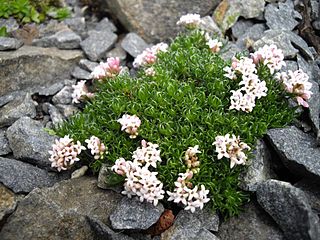
Asperula gussonei, also known as alpine woodruff, is a deciduous species of perennial groundcover, and a flowering plant in the family Rubiaceae. It was first described in 1831 and is endemic to Sicily.

Persicaria prostrata, basionym Polygonum prostratum, is a species of flowering plant in the family Polygonaceae, native to Australia and perhaps New Zealand. It is known by the common name of creeping knotweed.
Asperula accrescens is a deciduous species of perennial groundcover, and a flowering plant in the family Rubiaceae, known as Woodruff, and is endemic to Transcaucasus, and was first named by Klokov.
Asperula acuminata is a deciduous species of perennial groundcover, and a flowering plant in the family Rubiaceae, known as Woodruff, and is endemic to NE. New South Wales of Australia, and was first named by I.Thomps.
Asperula ambleia is a deciduous species of perennial groundcover, and a flowering plant in the family Rubiaceae, known as Stiff Woodruff, and is endemic from SE. Queensland to NE. Victoria in Australia, and was first named by Airy Shaw.
Asperula assamica is a deciduous species of perennial groundcover, and a flowering plant in the family Rubiaceae, known as Woodruff, and is endemic to Assam, East Himalayas, and was first named by Meisn.
Asperula asthenes is a species of flowering plant in the family Rubiaceae, known as trailing woodruff, and is endemic to the east coast of New South Wales, Australia




